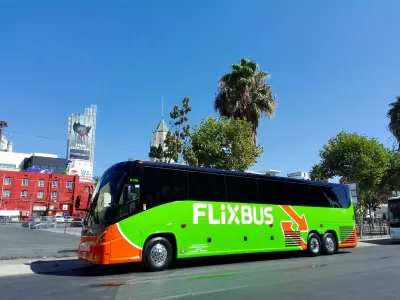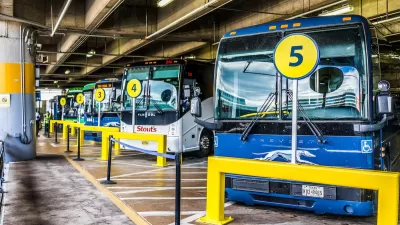Passengers continue to rely on intercity bus lines, even as cities shutter bus terminals and bus companies restructure to avoid financial failure.

Despite operators’ financial struggles and the closure of dozens of bus terminals around the country, intercity bus ridership is growing in the United States, prompting bus companies to expand their fleets, reveals a report from the Chaddick Institute. “Greyhound acquired 60 motor coaches last year; Trailways, 30; and Peter Pan, 15. The Motorcoach Builders Survey for the third quarter of 2024 saw sales of new coaches up over 15% from the same period in the previous year.”
According to a Smart Cities Dive piece by Dan Zukowski, intercity buses provided almost 50 million riders in 2023, and ridership could grow by as much as 4 percent this year — higher than growth in air travel. Colorado’s Bustang line carried almost 280,000 riders in 2023. Other state-supported bus services are available in North Carolina, Virginia, and Washington,and Maine launched a new intercity service last year.
As Zukowski notes, “State services like these are made possible by the Federal Transit Administration’s formula grants for rural areas program, also known as Section 5311.”
However, the report warns that closures of terminals have slowed ridership recovery in rural and secondary routes, and some urban bus terminals are on the chopping block or have already closed down.
FULL STORY: Intercity bus service on the upswing

Manufactured Crisis: Losing the Nation’s Largest Source of Unsubsidized Affordable Housing
Manufactured housing communities have long been an affordable housing option for millions of people living in the U.S., but that affordability is disappearing rapidly. How did we get here?

Americans May Be Stuck — But Why?
Americans are moving a lot less than they once did, and that is a problem. While Yoni Applebaum, in his highly-publicized article Stuck, gets the reasons badly wrong, it's still important to ask: why are we moving so much less than before?

Research Shows More Roads = More Driving
A national study shows, once again, that increasing road supply induces additional vehicle travel, particularly over the long run.

Judge Halts Enforcement of Anti-Homeless Laws in Grants Pass
The Oregon city will be barred from enforcing two ordinances that prosecute unhoused residents until it increases capacity and accessibility at designated camping sites.

Advancing Sustainability in Los Angeles County Schools
The Los Angeles County Office of Education’s Green Schools Symposium brings together educators, students, and experts to advance sustainability in schools through innovative design, climate resilience strategies, and collaborative learning.

Using Old Oil and Gas Wells for Green Energy Storage
Penn State researchers have found that repurposing abandoned oil and gas wells for geothermal-assisted compressed-air energy storage can boost efficiency, reduce environmental risks, and support clean energy and job transitions.
Urban Design for Planners 1: Software Tools
This six-course series explores essential urban design concepts using open source software and equips planners with the tools they need to participate fully in the urban design process.
Planning for Universal Design
Learn the tools for implementing Universal Design in planning regulations.
City of Moreno Valley
Institute for Housing and Urban Development Studies (IHS)
City of Grandview
Harvard GSD Executive Education
NYU Wagner Graduate School of Public Service
City of Cambridge, Maryland
Newport County Development Council: Connect Greater Newport





























